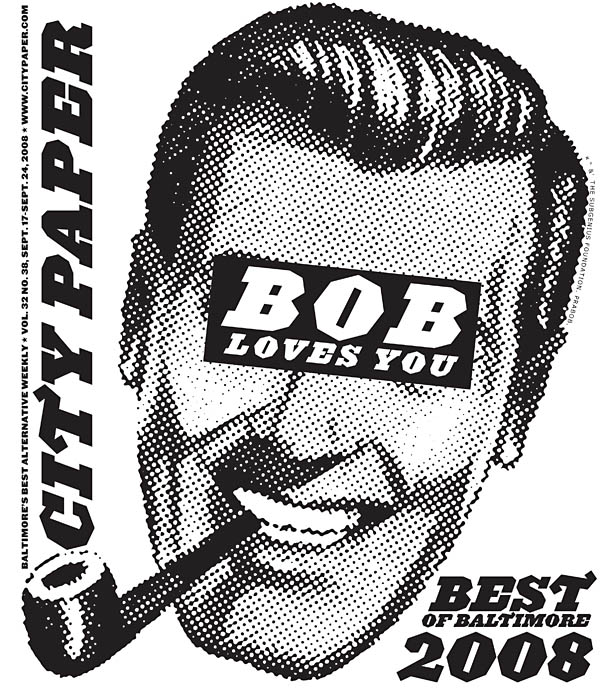
Originally Posted at Citypaper.com
The Illusionists
Looks can be deceiving in this smart, polished group show
By Alex Ebstein
Decoy, the exhibition currently on view at the Creative Alliance, makes you look twice and question what you see. Each of the art works in this show, curated by Erin Cluley, causes you to waver between its surface attraction and a deeper message, which you reconsider upon each viewing. Visually airy with an array of edgy undertones, Decoy lures you in and dares you to be shallow.
Jenny Mullins' drawings of majestic birds, with their detail and clean stylization, resemble both postage stamps and propaganda posters. In each image, the birds are bound and constricted by rope, or disfigured by belts and sequined, yellow hoods. Dotted with a barrage of arrows and aggressive flag poles, it is uncertain whether the images are supposed to read as victorious or sympathetic. In "Sacrifice to the Economy," a single bird of prey's feathers bulge against bindings, and strings trail out of the composition from the tiny arrows along its back. With its head obscured by a traditional falcon hood--albeit one bespangled with sequins--the bird is either blinded against the violence being acted upon it or made vulnerable by its hooded condition. Verging on satirical illustration, Mullins plays on contemporary American tensions and the constriction of national pride.
Paul Jeanes' oil paintings of lush cloud formations offer the initial impression of photographs taken from an elevated or hovering perspective, and they're hung along the back wall of the exhibition to create such an illusion. The hand and the medium become obvious at a closer range, but the images then reveal hidden details--a flock of birds, a helicopter--invading otherwise pristine cloudscapes. Jeanes' artist's statement claims that the paintings--from his series, "Not to Touch the Earth (1000 Skies for Mies van de Rohe)"--are based on the view from the van de Rohe-designed Highfield House in the Tuscany-Canterbury neighborhood. In a similar celestial study, Jeanes includes a grid of small paintings of the moon. Next to the imposing cloud triptych, the small images, while charming, are relatively unambitious, and the moments captured are less interesting.
Michael Mansfield's two charcoal drawings examine views from space. At their massive scale--100 by 100 inches and 104 by 132 inches, respectively--the drawings appear to be elegant, topographical data charts of remote or imagined islands. Indicating a satellite's perspective and mapping unidentified landmarks by using nodes of varied sizes, the information relayed becomes a pattern of indeterminable possibilities: clusters of people, military units, cell phone towers, McDonald's locations, etc. Mansfield simultaneously celebrates the awe of technology and examines the unease of its potential by letting his viewers fill in the blank as to why such data is being gathered.
Robert Horvath's tantalizingly slick, shiny paintings look like exotic floral still-lifes from afar, but up close they reveal a germ-like, organic structure more akin to a science project. The gaseous bubbling, cell-like structures billow and glow against their stark, black backgrounds. The radiant, bulbous forms have an uneasy hostility, like an unstoppable, alien disease--think The Blob, only prettier--swelling across the paintings' surface. Hanging on either side of Kendra Lee Hebel's "Sugarpus"--a set of three costumes made from resin and hair--Horvath echoes Hebel's more obvious play on the value of beauty.
Hebel's three dresses, worn by white mannequins, directly contrast the clean form of the body with physical anomalies and asks--not so subtly--which is more interesting. The tactile, overpowering dresses, made of synthetic hair and rubber silicon, mimic body hair and growths, while cut and presented like delicate ballet costumes. Worn by live models during the opening, and undoubtedly made more startlingly organic through movement, "Sugarpus" finds exoticism in moles, hair, and cancerous growths.
Decoy is a smart show, successfully drawing parallels and pairing works one might never have considered complementary. Bringing together artists working in a variety of media, size and subject matter, Cluley presents a realized exhibition with an overall message and curatorial statement: Things aren't always what they appear to be. While the exhibition is positively polished, attractive and professional, if you get stuck on the surface, you're missing the point.















